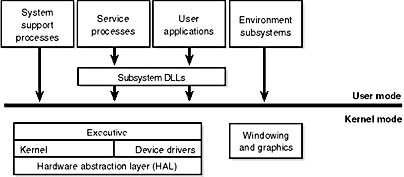Architecture Overview
With this brief overview of the design goals and packaging of Windows 2000, let's take a look at the key system components that comprise its architecture. A simplified version of this architecture is shown in Figure 2-2. Keep in mind that this diagram is basic—it doesn't show everything. The various components of Windows 2000 are covered in detail later in this chapter.

Figure 2-2 Simplified Windows 2000 architecture
In Figure 2-2, first notice the line dividing the user-mode and kernel-mode parts of the Windows 2000 operating system. The boxes above the line represent user-mode processes, and the components below the line are kernel-mode operating system services. As mentioned in Chapter 1, user-mode threads execute in a protected process address space (although while they are executing in kernel mode, they have access to system space). Thus, system support processes, service processes, user applications, and environment subsystems each have their own private process address space.
The four basic types of user-mode processes are described as follows:
- Fixed (or hardwired) system support processes, such as the logon process and the session manager, that are not Windows 2000 services (that is, not started by the service control manager).
- Service processes that host Win32 services, such as the Task Scheduler and Spooler services. Many Windows 2000 server applications, such as Microsoft SQL Server and Microsoft Exchange Server, also include components that run as services.
- User applications, which can be one of five types: Win32, Windows 3.1, MS-DOS, POSIX, or OS/2 1.2.
- Environment subsystems, which expose the native operating system services to user applications through a set of callable functions, thus providing an operating system environment, or personality. Windows 2000 ships with three environment subsystems: Win32, POSIX, and OS/2.
In Figure 2-2, notice the "Subsystem DLLs" box below the "Service processes" and "User applications" boxes. Under Windows 2000, user applications don't call the native Windows 2000 operating system services directly; rather, they go through one or more subsystem dynamic-link libraries (DLLs). The role of the subsystem DLLs is to translate a documented function into the appropriate internal (and undocumented) Windows 2000 system service calls. This translation might or might not involve sending a message to the environment subsystem process that is serving the user application.
The kernel-mode components of Windows 2000 include the following:
- The Windows 2000 executive contains the base operating system services, such as memory management, process and thread management, security, I/O, and interprocess communication.
- The Windows 2000 kernel consists of low-level operating system functions, such as thread scheduling, interrupt and exception dispatching, and multiprocessor synchronization. It also provides a set of routines and basic objects that the rest of the executive uses to implement higher-level constructs.
- Device drivers include both hardware device drivers that translate user I/O function calls into specific hardware device I/O requests as well as file system and network drivers.
- The hardware abstraction layer (HAL) is a layer of code that isolates the kernel, device drivers, and the rest of the Windows 2000 executive from platform-specific hardware differences (such as differences between motherboards).
- The windowing and graphics system implements the graphical user interface (GUI) functions (better known as the Win32 USER and GDI functions), such as dealing with windows, user interface controls, and drawing.
Table 2-1 lists the filenames of the core Windows 2000 operating system components. (You'll need to know these filenames because we'll be referring to some system files by name.) Each of these components is covered in greater detail both later in this chapter and in the chapters that follow.
Table 2-1 Core Windows 2000 System Files
| Filename | Components |
|---|---|
| Ntoskrnl.exe | Executive and kernel |
| Ntkrnlpa.exe | Executive and kernel with support for Physical Address Extension (PAE), which allows addressing of up to 64 GB of physical memory |
| Hal.dll | Hardware abstraction layer |
| Win32k.sys | Kernel-mode part of the Win32 subsystem |
| Ntdll.dll | Internal support functions and system service dispatch stubs to executive functions |
| Kernel32.dll, Advapi32.dll, User32.dll, Gdi32.dll | Core Win32 subsystem DLLs |
Before we dig into the details of these system components, though, let's examine the differences between Windows 2000 Professional and the various editions of Windows 2000 Server.
EAN: 2147483647
Pages: 121